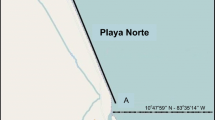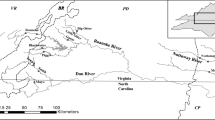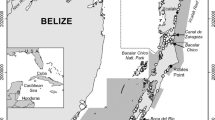Abstract
Recruitment of walleye (Sander vitreus Mitchill) is limited in irrigation reservoirs of the Republican River basin in southwestern Nebraska. The causal mechanism for this limited recruitment is unknown, but may be related to a lack of suitable spawning habitat. Patch occupancy models were developed to describe variation in detection probability and habitat selection during spawning season using shoreline electrofishing data. Detection of adult walleye was negatively affected by water temperature, silt substrate, and woody cover. Adult walleye selected sites with cooler water temperatures and greater fetch at Enders Reservoir, and large rock substrate and no cover at Hugh Butler Lake; these characteristics are limited to areas on or near the riprap dams in both reservoirs. Walleye eggs were also only found in these areas. We conclude that patch occupancy modeling provided valuable information when considering habitat improvement projects and propose a management approach for the addition of walleye spawning habitat in irrigation reservoirs.



Similar content being viewed by others
References
Becker GC (1983) Fishes of Wisconsin. University of Wisconsin Press, Madison
Burdick SM, Hendrixson HA, VanderKooi SP (2008) Age-0 Lost River sucker and shortnose sucker nearshore habitat use in Upper Klamath Lake, Oregon: a patch occupancy approach. Trans Am Fish Soc 137:417–430
Burkhardt RW, Gutreuter S (1995) Improving electrofishing catch consistency by standardizing power. North Am J Fish Manag 15:375–381
Burnham KP, Anderson DR (2002) Model selection and multimodel inference: a practical information-theoretic approach, 2nd edn. Springer, New York
Carlander KD (1945) Age, growth, sexual maturity, and population fluctuations of the yellow pike-perch, Stizostedion vitreum vitreum (Mitchill), with reference to the commercial fisheries, Lake of the Woods, Minnesota. Trans Am Fish Soc 73:90–107
Chalupnicki MA, Johnson JH, McKenna JE Jr, Dittman DE (2010) Habitat selection and spawning success of walleyes in a tributary to Owasco Lake, New York. North Am J Fish Manag 30:170–178
Gipson RD, Hubert WA (1993) Spawning-site selection by kokanee along the shoreline of Flaming Gorge Reservoir, Wyoming-Utah. North Am J Fish Manag 13:475–482
Gosch NJC, Phelps QE, Willis DW (2006) Habitat characteristics at bluegill spawning colonies in a South Dakota glacial lake. Ecol Freshw Fish 15:464–469
Grinstead BG (1971) Reproduction and some aspects of the early life history of walleye, Stizostedion vitreum (Mitchill) in Canton Reservoir, Oklahoma. In: Hall GE (ed), Reservoir fisheries and limnology. Am Fish Soc Spec Pub 8, Washington, D.C. pp. 41–51
Groen CL, Schroeder TA (1978) Effects of water level management on walleye and other coolwater fishes in Kansas reservoirs. Am Fish Soc Spec Publ 11:278–283
Gu W, Swihart RK (2004) Absent or undetected? Effects of non-detection of species occurrence on wildlife-habitat models. Biol Conserv 116:195–203
Halbert CL (1993) How adaptive is adaptive management? Implementing adaptive management in Washington State and British Columbia. Rev Fish Sci 1:261–283
Hayer CA, Irwin ER (2008) Influence of gravel mining and other factors on detection probabilities of coastal plain fishes in the Mobile River basin, Alabama. Trans Am Fish Soc 137:1606–1620
Hines JE (2006) PRESENCE2—Software to estimate patch occupancy and related parameters. USGS-PWRC. http://www.mbr-pwrc.usgs.gov/software/presence.html
Johnson FH (1961) Walleye egg survival during incubation on several types of bottom in Lake Winnibigoshish, Minnesota, and connecting waters. Trans Am Fish Soc 90:312–322
Katt JD, Peterson BC, Koupal KD, Schoenebeck CW, Hoback WW (2011) Changes in relative abundance of adult walleye and egg density following the addition of walleye spawning habitat in a midwest irrigation reservoir. J Fresh Ecol 26:51–58
Kelder BF, Farrell JM (2009) A spatially explicit model to predict walleye spawning in an Eastern Lake Ontario tributary. North Am J Fish Manag 29:1686–1697
MacKenzie DI, Royle JA (2005) Designing occupancy studies: general advice and allocating survey effort. J App Ecol 42:1105–1114
MacKenzie DI, Nichols JD, Lachman GB, Droege S, Royle JA, Langtimm CA (2002) Estimating site occupancy rates when detection probabilities are less than one. Ecology 83:2248–2255
Martin DR (2008) Habitat selection by spawning walleye and white bass in irrigation reservoirs of the Republican River Basin, Nebraska. Thesis, University of Nebraska—Lincoln
McMahon TE, Terrell JW, Nelson PC (1984) Habitat suitability information: walleye. Fish and Wildlife Service, U.S. Department of the Interior, FWS/OBS-82/10.56, Washington, DC
Pflieger WL (1997) The fishes of Missouri, revised edition. Missouri Department of Conservation, Jefferson City
Priegel GR (1970) Reproduction and early life history of the walleye in the Lake Winnebago region. Wisconsin Department of Natural Resources Technical Bulletin 45, Madison
Quist MC, Guy CS, Bernot RJ, Stephen JL (2004) Factors related to growth and survival of larval walleyes: implications for recruitment in a southern Great Plains reservoir. Fish Res 67:215–225
Reynolds JB (1996) Electrofishing. In: Murphy BR, Willis DW (eds) Fisheries techniques, 2nd edn. American Fisheries Society, Bethesda, pp 221–253
Schoenebeck CW, Hansen MJ (2005) Electrofishing catchability of walleye, largemouth bass, smallmouth bass, northern pike, and muskellunge in Wisconsin Lakes. North Am J Fish Manag 25:1341–1352
Schreck CB, Moyle PB (1990) Methods for fish biology. American Fisheries Society, Bethesda
Scott WB (1967) Freshwater fishes of eastern Canada. University of Toronto Press, Toronto
Tyre AJ, Tenhumberg B, Field SA, Niejalke D, Parris K, Possingham HP (2003) Improving precision and reducing bias in biological surveys: estimating false-negative error rates. Ecol App 13:1790–1801
Van Eenennaam JP, Linares-Casenave J, Deng X, Doroshov SI (2005) Effect of incubation temperature on green sturgeon embryos, Acipenser medirostris. Environ Biol Fish 72:145–154
Zalewski M, Cowx IG (1990) Factors affecting the efficiency of electric fishing. In: Cowx IG, Lamarque P (eds) Fishing with electricity: applications in freshwater fisheries management. Fishing News Books, Oxford, pp 89–111
Acknowledgements
We thank Chris Lewis and many volunteers for assistance with field work. We also thank Mark Fincel and Mark Pegg for helpful comments on earlier drafts of this manuscript. This project was funded by Federal Aid in Sport Fish Restoration, project F-174-R, administered by the Nebraska Game and Parks Commission. LAP’s contribution was supported by Hatch Act funds through the University of Nebraska Agricultural Research Division, Lincoln, Nebraska. Reference to trade names does not imply endorsement by the authors or any U.S. Government. The Nebraska Cooperative Fish and Wildlife Research Unit is jointly supported by a cooperative agreement among the U.S. Geological Survey, the Nebraska Game and Parks Commission, the University of Nebraska, the U.S. Fish and Wildlife Service, and the Wildlife Management Institute.
Author information
Authors and Affiliations
Corresponding author
Rights and permissions
About this article
Cite this article
Martin, D.R., Powell, L.A. & Pope, K.L. Habitat selection by adult walleye during spawning season in irrigation reservoirs: a patch occupancy modeling approach. Environ Biol Fish 96, 429–438 (2013). https://doi.org/10.1007/s10641-011-9939-3
Received:
Accepted:
Published:
Issue Date:
DOI: https://doi.org/10.1007/s10641-011-9939-3




